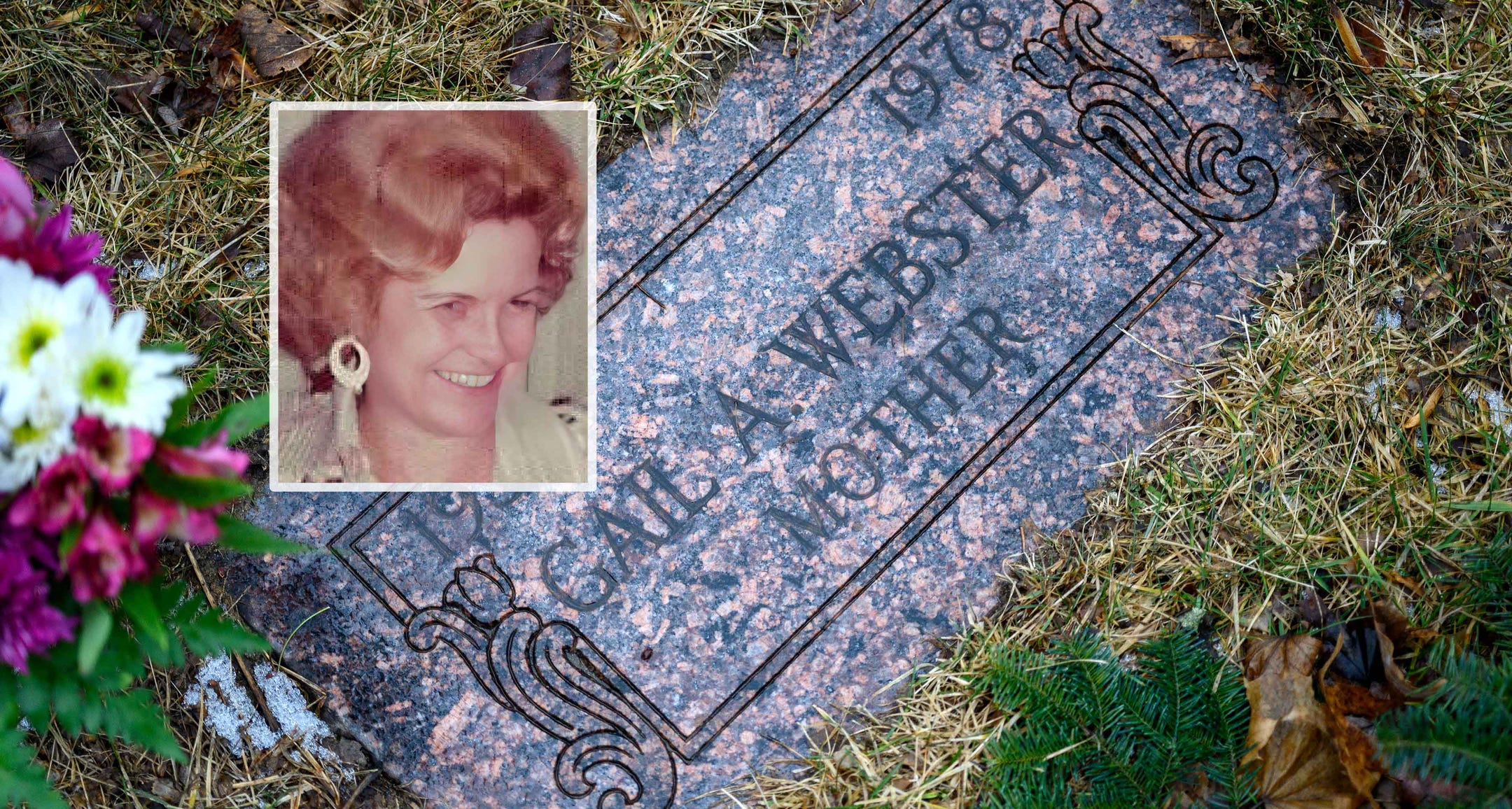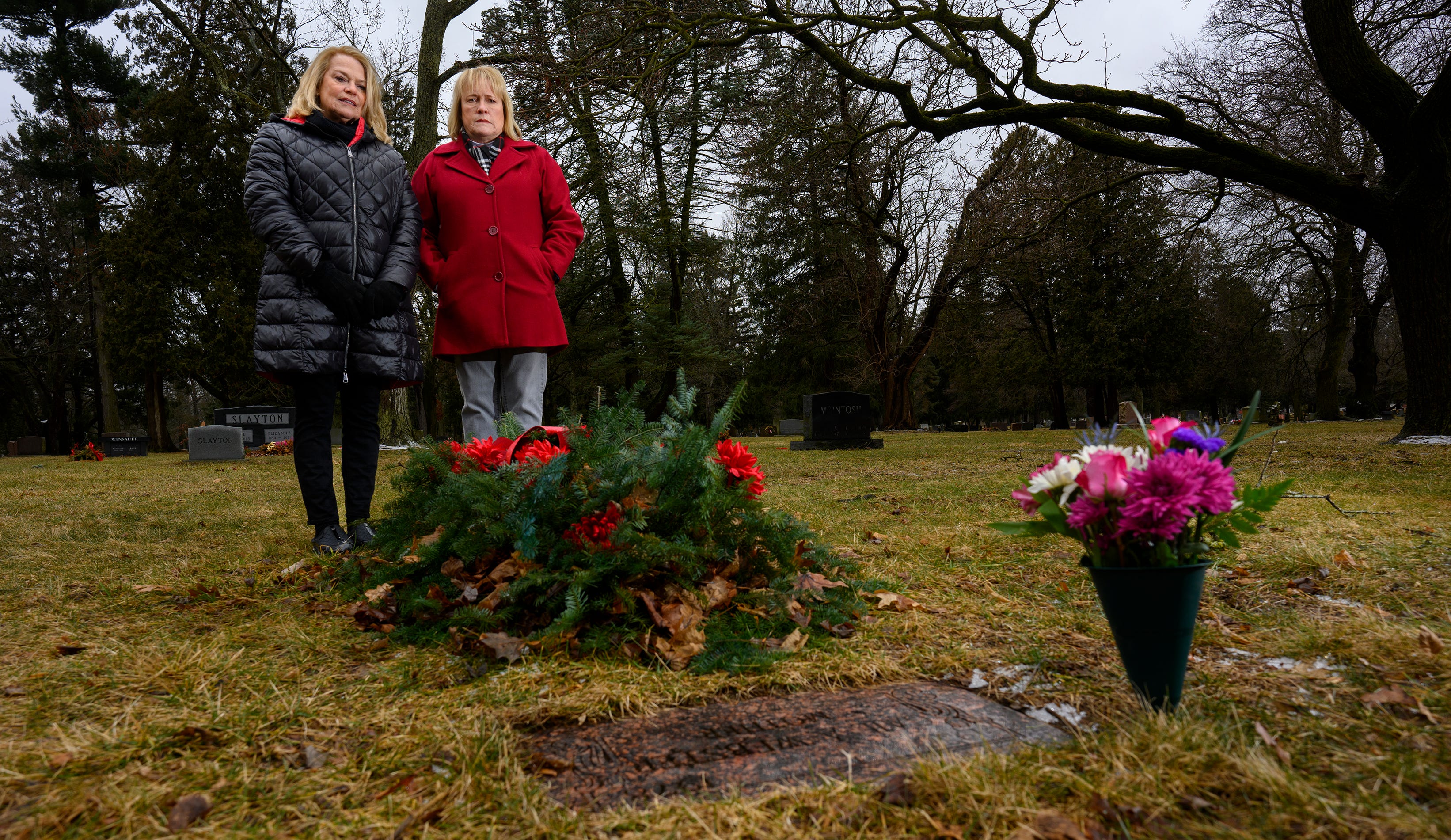
Shown is the headstone of Gail Webster, a 48-year-old divorced mother of three, who was murdered in her apartment in Troy on Oct. 28, 1978. Andy Morrison, The Detroit News
Shown is the headstone of Gail Webster, a 48-year-old divorced mother of three, who was murdered in her apartment in Troy on Oct. 28, 1978. Andy Morrison, The Detroit News
Nearly 45 years ago on a warm October night in 1978, Gail Webster, 48, was bludgeoned to death in her second-floor Somerset Park apartment near Interstate 75 in Troy.
She had been discovered lying on the carpet in her nightgown by her daughter, Terry, then 25. Both Terry and her sister, Wendy, then 21, lived with their mother. The oldest of Webster’s three daughters, Cindy Kujawski, lived with her husband in nearby Berkley.
Gail Webster worked for 15 years as a hostess and day manager at the popular Susie-Q restaurant in Royal Oak where she was well-liked and respected. She had been divorced from her husband for three years after a 24-year marriage. Her daughters and grandchildren adored her.


For more than four decades, the case languished in the cold case files, despite year-in, year-out appeals from family members to get police to investigate their mother’s case more aggressively.
Yet the pandemic that brought misery to so many brought hope to the family of Gail Webster. With a diminished investigative workload in the early days of the COVID-19 outbreak, a Troy lieutenant decided to give Webster’s case a fresh look.
With it came discoveries, including a possible murder weapon in police custody. And the possibility that renewed attention — and DNA evidence — might finally lead to the killer.
It’s an accounting they initially feared might never come. That’s because Webster’s family insist they now know why the case had initially reached a dead end: the fix was in long ago.
“No matter how hard we push or for how long, they can’t find anything because someone made sure there wouldn’t be any evidence to find,” Terry Webster King said. “This case was deliberately bungled from the very beginning.
“We believe our mother was killed because she learned something or saw something she wasn’t supposed to."
There was reason for their suspicion. Up until the pandemic, the long odyssey had yielded nothing. The rollercoaster of hopes dashed over the years had included: a plea to convene a grand jury in the 1980s, the disinterment of their mother’s body in the '90s, and, eventually, a media effort lost amid a conspiracy to kidnap Michigan’s governor.
By all accounts, this case was emblematic of the many pitfalls inherent in long-unsolved murder cases: how time decays evidence but not the acute trauma of the loss; how turnover in law enforcement repeatedly sets investigations back; how varying standards for storage and purging old criminal records can be devastating; and how, while there is hope in the latest science, there is not always certainty.
For its part, Troy Police Department takes responsibility for the missing evidence. “That’s one of the things our guys could have done better,” Capt. Josh Jones said. “Even though none of us were here in 1978, a lot of us still take ownership of this case because it’s our police department. It’s our city.”
But they stop short of anything nefarious on the part of law enforcement. “I understand that people tend to fill in the blank when they don’t know the answer,” Jones said. “And I can certainly understand the family’s feelings. If it was my mother, everything that they are doing, I would be doing."
For all the failures, Webster’s case had promise, however, because there was still a strong lead.
No one would deny that the prime suspect, Robert Van Hengel, had secrets to keep. After all, the former ATF agent who had dated Gail Webster briefly in the past was investigated as a person of interest in the infamous Oakland County Child Killer case. Long the scourge of the affluent county, the unsolved case in which four children were abducted and murdered took place during 13 months in 1976 and 1977, the same time frame Webster and Van Hengel were dating.

Still, the latest effort by the Troy police gave the family new hope.
In spring 2022, Terry Webster King and Wendy Webster Razlog encouraged Troy police to explore sending DNA evidence in their mother’s case to a third-party lab for advanced DNA testing using forensic genetic genealogy.
The increasingly successful technique unlocking cold cases nationwide was first used to identify the Golden State Killer, and, more recently, the suspect in the slayings of four Idaho college students.
Troy police, along with the Michigan State Police, spent months interviewing several of the leading labs in the country to find the best fit and decided on DNA Labs International in Florida.
DNA Labs International is able to salvage degraded or partial DNA samples (commonly found in decades-old cases) and create DNA profiles from them. Genetic genealogists then search for similar genetic markers in that unknown individual’s DNA profile that might also belong to distant relatives in DNA databases.
“We are looking for overlapping DNA,” said Rachel H. Oefelein, chief scientist of DNA Labs International. The more markers, the more closely related a person is to that family line.”
By November 2022, all the physical evidence in the Webster case deemed as the most test-worthy had been compiled, packaged and transported to Florida, along with a rigorous chain-of-custody protocol.
“We are confident that we are submitting all viable evidence,” Jones, the Troy police captain, wrote in a letter to the Websters, “and doing everything possible to do our part to find the responsible person for your mother’s death.”
It is safe to say that if the Webster family or law enforcement had to name whom the DNA results would point to, both would say Van Hengel. On this they agree: the former ATF agent, who died in 2006 at age 70, is the strongest suspect in the killing of Gail Webster.
But why Van Hengel would commit such a heinous crime — his motive — is the point where the police and the victim’s family’s views diverge.
Terry Webster King and Wendy Webster Razlog suspect their mother was targeted by Van Hengel because of his link to the Oakland County Child Killer case. Van Hengel had two tips called in on him, one from a task force officer at the time and another from a waitress who used to work with Gail Webster at Susie-Q, the popular Woodward Avenue restaurant.
In 2009, The Detroit News was first to report that the identity of the No. 1 suspect in the child killings that had seized the tri-county area in a state of panic had been kept hidden in the Michigan State Police records vault for more than 30 years. The story also unveiled an underground multimillion-dollar child sex trafficking and pornography ring operating in Metro Detroit in the 1970s and '80s.
Gail Webster’s family theorize that same cover-up extended to Van Hengel. Someone in law enforcement turned a blind eye, they believe, resulting in critical evidence missing for decades and a suspicious weapon not being recovered until 1995.

“From the very beginning, we felt that we were being shoved aside,” Webster King said. “We approached the detectives many times throughout the years with questions, and we were repeatedly stonewalled.”
Added Webster Razlog: “It’s the only explanation that makes sense.”
It took many years of badgering, but finally in 2020 the sisters say a now-retired Troy cop leveled with them: This case could have been solved long ago.
At the least, the family of Gail Webster hoped for a full and honest accounting. Said Webster Razlog: “That is all we’ve ever wanted.”

Part Two
Day Two: The devastating discovery of Gail’s body in her Troy apartment leaves few clues. There is nothing of value missing; her wallet and purse are untouched. Investigators seemingly have little to go on. It is suspected that stolen keys to the apartment might have provided the killer access. Those closest to Gail Webster are interrogated first, including the ex-husband, current boyfriend and former boyfriend. The first two are cleared, but as the former boyfriend becomes less and less cooperative, suspicions heighten.
 Marney Rich Keenan is a retired Detroit News reporter and columnist and author of “The Snow Killings: Inside the Investigation into the Oakland County Child Killer” (McFarland Books, July, 2020). The case involved the abduction and murders of four children over a 13-month period in 1976 and 1977. It has never been solved.
Marney Rich Keenan is a retired Detroit News reporter and columnist and author of “The Snow Killings: Inside the Investigation into the Oakland County Child Killer” (McFarland Books, July, 2020). The case involved the abduction and murders of four children over a 13-month period in 1976 and 1977. It has never been solved.